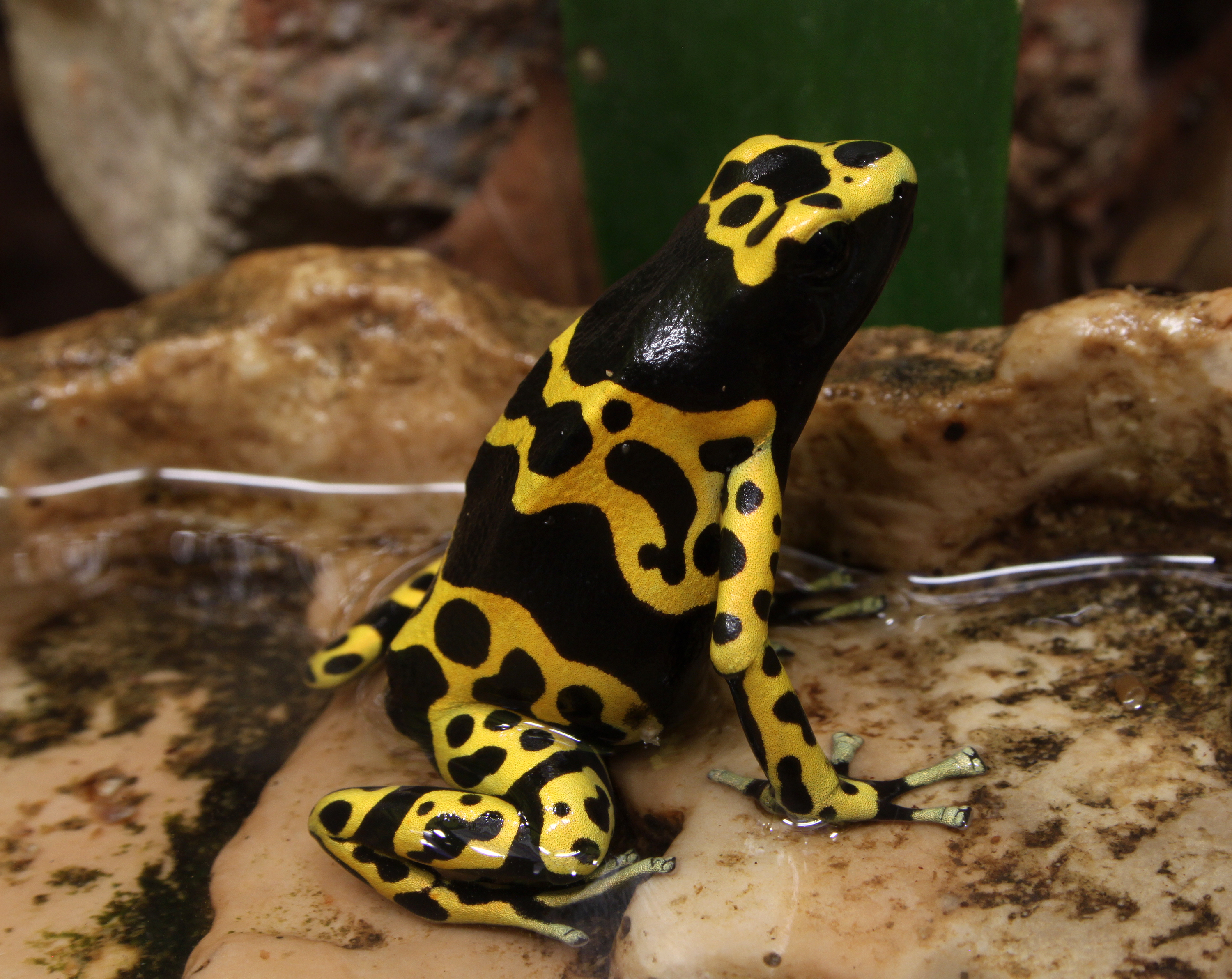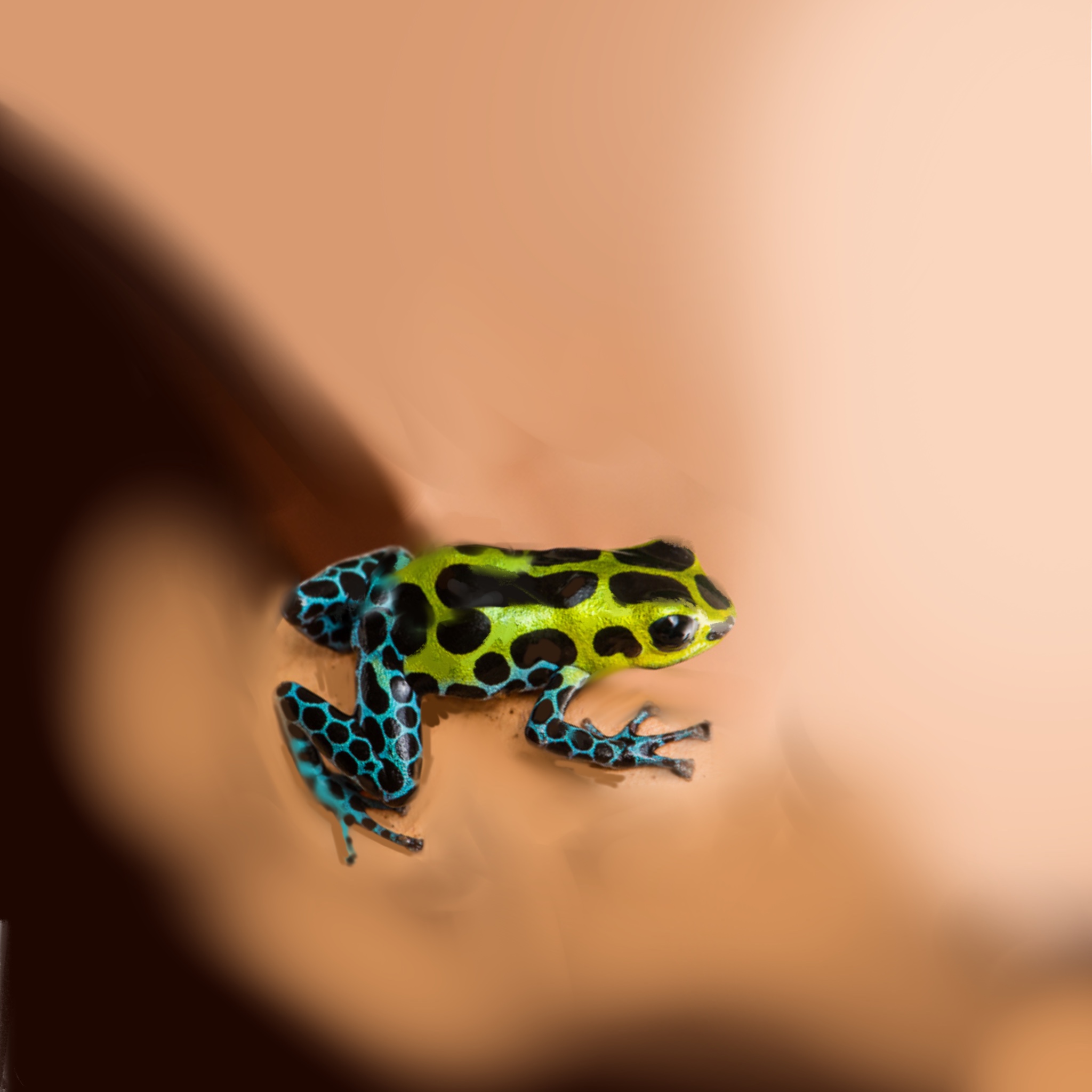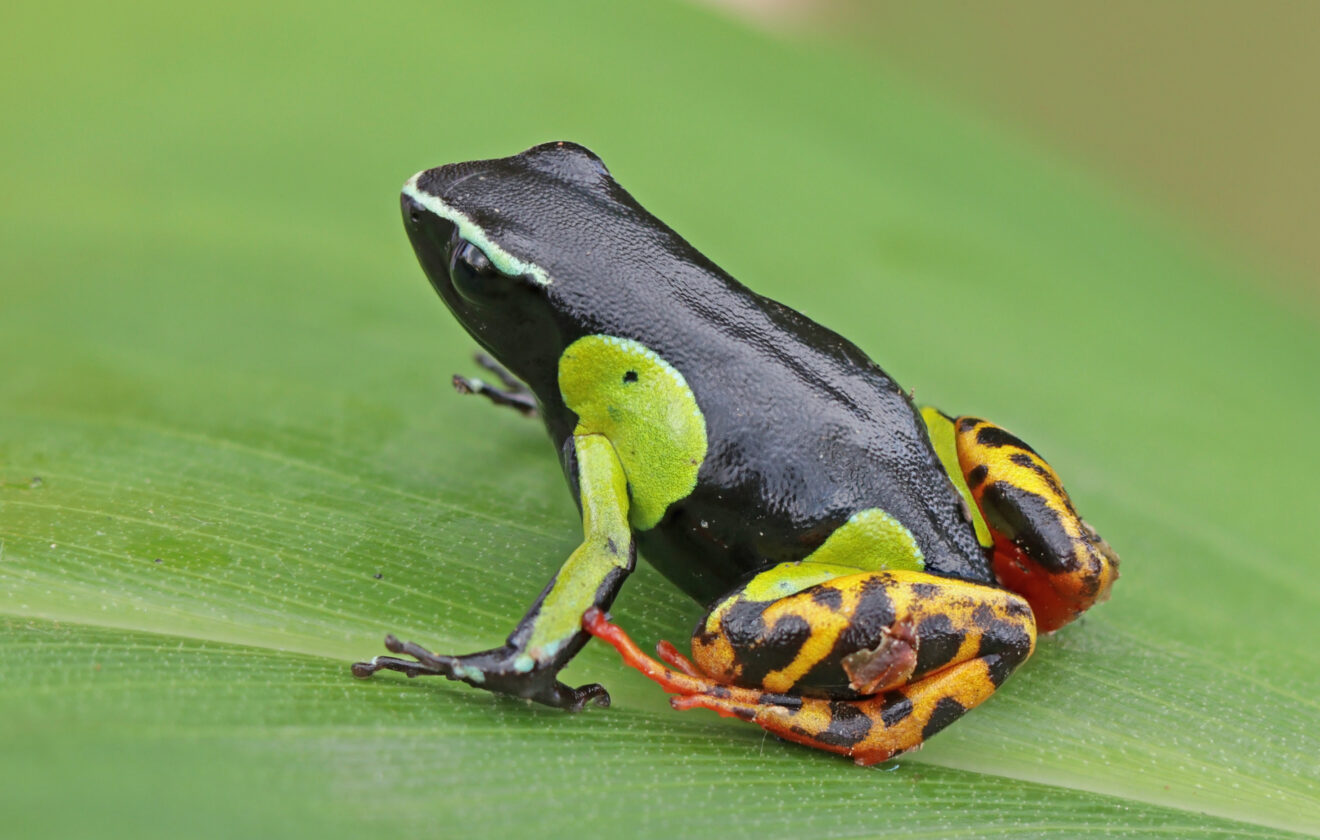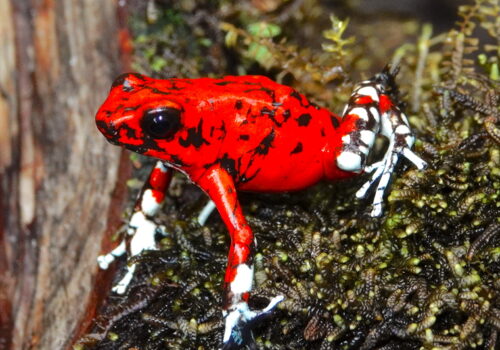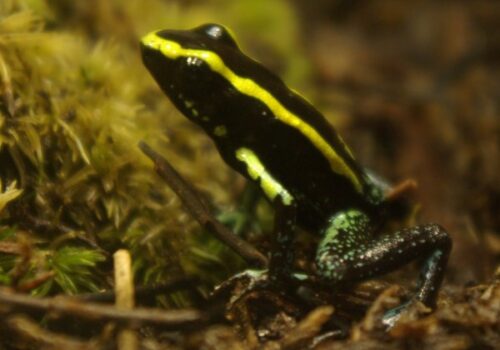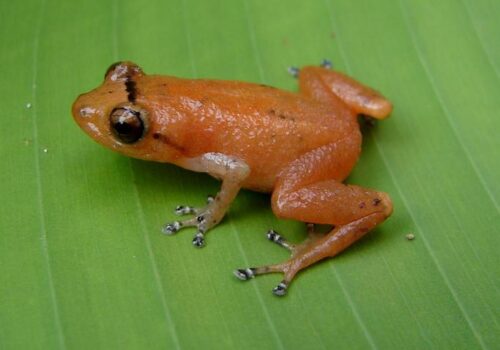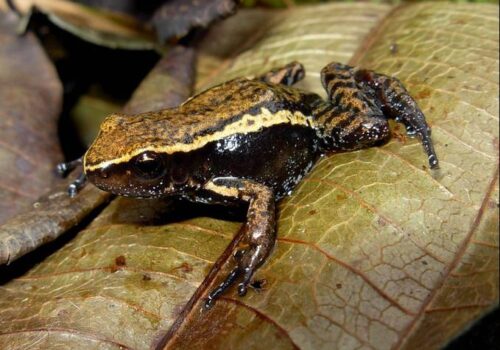- Unveiling Ranitomeya flavovittata: The Vibrant Jewel of Peru’s Rainforests
- Taxonomy and Classification of Ranitomeya flavovittata
- A Symphony of Shadows and Light: Natural Habitat of Ranitomeya flavovittata
- A Jewel in Miniature: Physical Characteristics and Adaptations
- Life Beneath the Leaves: Behavior and Life Cycle
- The Delicate Balance: Ecological Role of Ranitomeya flavovittata
- Conservation Challenges: Protecting the Precious Jewels of the Rainforest
- The Golden Stripe of Hope: Celebrating Ranitomeya flavovittata
Unveiling Ranitomeya flavovittata: The Vibrant Jewel of Peru’s Rainforests#
In the verdant jungles where sunlight dances through layers of lush foliage and the air hums with the whispers of countless forms of life, a tiny, jewel-like creature lives unseen by many, yet it captivates the curiosity and admiration of those fortunate enough to discover it. Meet Ranitomeya flavovittata, a dart frog as captivating in appearance as it is intriguing in its behavior and ecological significance.
Despite its diminutive size, typically no larger than a human thumbnail, this species commands attention thanks to its striking coloration and intricate patterns. Aptly nicknamed the Yellow-striped Poison Dart Frog, Ranitomeya flavovittata showcases the exquisite artistry of nature: vibrant stripes of golden-yellow contrast dramatically against jet-black background, creating a color scheme reminiscent of warning signs meant to deter predators. Yet, behind its vivid colors lies much more than just a defensive adaptation—there exists a story of fascinating ecology, stealthy habits, and vital conservation importance.
Taxonomy and Classification of Ranitomeya flavovittata#
Ranitomeya flavovittata belongs to the fascinating family Dendrobatidae, commonly known as poison dart frogs. Within this family, frogs are notorious for secreting alkaloid toxins through their skin as a defense mechanism—a hallmark which has earned them their colorful, flamboyant reputations. Nestled firmly within this illustrious lineage, the genus Ranitomeya is differentiated by their exceptionally small size and meticulous parental care behaviors.
Discovered and scientifically described relatively recently, Ranitomeya flavovittata has become a subject of significant intrigue among herpetologists and conservationists alike. Among its close relatives, such as Ranitomeya imitator and Ranitomeya ventrimaculata, R. flavovittata distinguishes itself through distinctive coloration patterns and specialized ecological adaptations. Its taxonomic classification is as follows:
- Kingdom: Animalia
- Phylum: Chordata
- Class: Amphibia
- Order: Anura
- Family: Dendrobatidae
- Genus: Ranitomeya
- Species: Ranitomeya flavovittata
A Symphony of Shadows and Light: Natural Habitat of Ranitomeya flavovittata#
Ranitomeya flavovittata holds secrets snugly wrapped within the pristine rainforests of Peru, specifically inhabiting the Amazonian lowlands and foothills of the Andean valleys. Primarily recorded within the San Martín and Loreto regions, this tiny amphibian flourishes in areas rich in humidity, dense vegetation, fallen leaves, and epiphytic plants like bromeliads, where water pools create the ideal nurseries for its tiny offspring.
Within the deep understory canopy, sunlight gently filters downward in fragmented bursts, casting patches of dappled gold amid cool green shadows. These twilight-lit realms form the perfect stage for Ranitomeya flavovittata to thrive, shelter, and hunt. Typically found clinging to damp foliage, bromeliad interiors, and leaf litter, this miniature predator navigates its complex microhabitat with astounding ease. Its environment not only meets its basic necessities but embodies the very fabric woven into its evolutionary tale—the interactive web of prey, predators, and reproduction.
A Jewel in Miniature: Physical Characteristics and Adaptations#
To the vigilant observer, the first glimpse of Ranitomeya flavovittata often triggers astonishment over the intensity of its color display. Measuring barely 15 to 20 millimeters, this tiny frog profoundly exemplifies nature’s embrace of both beauty and functionality. Its brilliantly contrasted coloration—jet-black body ornamented with bright yellow stripes—serves as a vibrant beacon of caution against potential predators, a biological warning commonly termed aposematism.
The amphibian’s skin is smooth and glossy, shimmering under damp conditions in a mesmerizing play of shadows and reflections. Minute glands in its skin release toxin-laden secretions when threatened, deterring predatory birds, snakes, and mammals that quickly learn the lesson associated with its striking colors—consume at your peril.
Indeed, these frogs gain their toxic properties from their dietary habits. Consuming small arthropods—primarily ants and tiny mites—enables them to sequester alkaloid toxins from these insects, accumulating them into their own secretions. This intriguing chemical defense highlights an exceptional ecological adaptation, linking poison dart frogs intimately with their micro-environment.
Life Beneath the Leaves: Behavior and Life Cycle#
Every leaf and droplet within the jungle hides unseen dramas, and few stories surpass the intrigue of the Ranitomeya flavovittata‘s meticulous parenting and courtship rituals. Males entice females through complex vocalizations—soft, whistle-like calls that drift subtly within foliage, weaving a secret musical tapestry. These seducing sounds not only signal territory ownership but also showcase fitness to potential mates.
Once partners form, their meticulously selected nursery is often located within bromeliads or similar plant structures that trap water. It is here, within these tiny, secluded pools, that females carefully deposit their eggs. Parenthood in Ranitomeya flavovittata is an exceptional process that involves extensive attentive care. After the eggs hatch, developing tadpoles are carried one by one upon the father’s back—all graceful tenderness combined with herculean efforts—and safely deposited into remaining water-filled bromeliad leaf axils.
During this developmental period, tadpoles subsist on a mix of detritus and aquatic microorganisms, aided at times by supplemental nourishment provided by periodically revisiting parents—a remarkable behavior among dart frogs. After approximately 40 to 60 days, these tadpoles metamorphose into miniature replicas of their parents, ready to navigate the worlds of leaf litter and foliage independently, continuing cycles that have persisted over countless rainforest generations.
The Delicate Balance: Ecological Role of Ranitomeya flavovittata#
Beyond their remarkable biological narratives, species like Ranitomeya flavovittata contribute significantly to rainforest ecosystems. Their voracious predation upon ants, mites, and other small insects helps maintain the delicate balance of microfauna populations, indirectly influencing plant health, decomposition rates, and soil fertility.
Conversely, their role as prey for birds and small reptiles fortifies essential food webs, underscoring their critical ecological position. Importantly, amphibians such as dart frogs also serve as bioindicators, their presence signaling environmental health and resilience while their decline could portend deeper looming challenges.
Conservation Challenges: Protecting the Precious Jewels of the Rainforest#
The magnificent beauty and ecological importance of Ranitomeya flavovittata sharply contrast their underlying vulnerability. While currently listed by the International Union for Conservation of Nature (IUCN) as “Data Deficient,” ongoing habitat loss driven by deforestation, illegal logging, agriculture expansion, and climate change presents significant threats to their fragile populations.
Fortunately, awareness and conservation initiatives spearheaded by both local communities and global researchers aim to safeguard crucial rainforest habitats. Ecotourism, scientific research programs, and international policies have increasingly highlighted the urgency of preserving threatened amphibian habitats, providing hope for the future of these precious frogs.
The Golden Stripe of Hope: Celebrating Ranitomeya flavovittata#
Ultimately, the story of Ranitomeya flavovittata is one of both beauty and caution—from its evolutionary brilliance in stunning displays and impressive adaptations within complex ecological webs, to its vulnerability amid changing human-altered landscapes. Each tiny golden-striped frog exists as an ambassador of a silent, intricate rainforest tapestry that deserves our admiration and full protection.
By learning about this extraordinary amphibian, advocating for its continued existence, and supporting conservation action, we honor not only the enigmatic beauty of Ranitomeya flavovittata, but ultimately, the unparalleled diversity and integrity of one of Earth’s most remarkable natural habitats—the Amazon rainforest.

